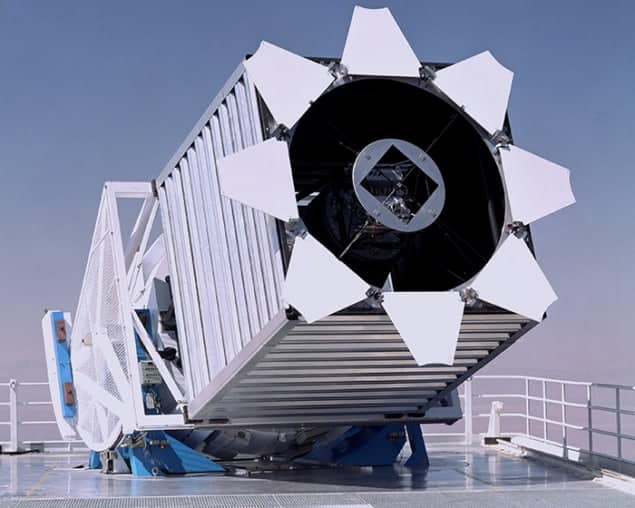
The first known white-dwarf star with an oxygen atmosphere has been spotted by astronomers from Brazil and Germany. The discovery comes as a complete surprise because an oxygen atmosphere is not predicted by any current theoretical model of stellar evolution. The researchers believe that the star’s original atmosphere of hydrogen and helium was stripped away, possibly by the gravitational pull of a companion star. The discovery could provide important information about how stars like the Sun evolve into white dwarfs.
“It’s quite outstanding,” says Boris Gänsicke of the University of Warwick in the UK, who was not involved in the discovery. “It’s a really rare, needle-in-a-haystack kind of discovery that you wouldn’t search for…but finding it may be a little but important piece in a jigsaw about stellar evolution.”
Becoming a white dwarf is the ultimate fate of most stars smaller than about 10 solar masses – including, of course, the Sun. After such a star burns up its helium via nuclear fusion, it sheds its outer layers and its core collapses under gravity to form a very dense ball of plasma that occupies about the same volume as the Earth. Most white dwarfs are unable to fuse carbon and have cores of carbon and oxygen. However, the heaviest stars that become white dwarfs are believed to undergo steady carbon fusion before collapsing into white dwarfs with cores of oxygen, neon and magnesium. These elements are difficult to observe, however, because gravity draws the heavier elements towards the core. The atmospheres of almost all white dwarfs are therefore dominated by the lightest elements – about 80% of white dwarfs have atmospheres dominated by hydrogen, and the rest by helium.
Star search
To find their white dwarf with an oxygen atmosphere, S O Kepler and Gustavo Ourique of the Federal University of Rio Grande do Sul and Detlev Koester of the University of Kiel combed through publically available data on 4.5 million stars from the Sloane Digital Sky Survey (SDSS).
It’s a really rare, needle-in-a-haystack kind of discovery that you wouldn’t search for
Boris Gänsicke, University of Warwick
The one star that they identified – called SDSS J124043.01+671034.68 – is 1200 light-years away and has an emission spectrum that suggests that its atmosphere is 96% oxygen. Neon and magnesium are the next most abundant elements, and the star also contains trace amounts of silicon and no detectable hydrogen or helium. Further analysis of the spectrum and comparison with mathematical models suggested that its mass is just over half that of the Sun. This makes the star even more puzzling, because a star that forms a white dwarf of this mass should be too small to undergo carbon fusion. Therefore, the white dwarf should not contain any oxygen at all, let alone at its surface.
The trio point out that several recent models suggest that, under specific circumstances, stars as small as 5.5 solar masses could undergo limited carbon fusion, creating a violent thermal pulse that would ignite off-centre and propagate outwards. However, this alone would not explain the observations, says Kepler: “These models say you might have a nucleus of carbon and an atmosphere of oxygen but do not predict that all the helium should be lost.” The final white-dwarf mass predicted in these models is also about one solar mass – much larger than seen here.
Stripped away
Kepler suggests that both of these problems could be resolved simultaneously if the outer layers were stripped away, exposing the products of carbon fusion beneath. He believes the most likely cause is interaction with another star: “To me, it must have come from a binary evolution,” he says. “It’s called a common envelope situation, where when you throw material into the white dwarf, it blows the envelope and the envelope is lost from both stars.” He cautions, however, that, “In a formal calculation, the stars do not lose that amount of mass.” More data are needed to develop the models and these should be forthcoming in the next few years from the GAIA space observatory, Kepler says.
Gänsicke points out a subtler but even stranger feature of the star’s spectrum than the oxygen atmosphere: the traces of silicon. “The nuclear burning must have proceeded one step further than the production of oxygen, neon and magnesium,” he says. “Most textbook astronomy would predict that, once you get to that [further] stage, you will not be able to stop nuclear burning all the way up to iron and you will produce a neutron star.”
The research is published in Science.



